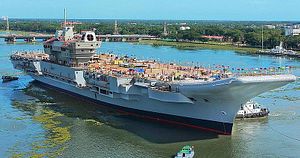India’s first domestically built aircraft carrier, the future INS Vikrant, designated Indigenous Aircraft Carrier 1 (IAC-1), will enter sea trials in early 2020, the Indian Ministry of Defense (MoD) said in a statement following the visit of Indian Defense Secretary Sanjay Mitra to the Cochin shipyards in Kochi in southern India on July 18.
“In-house trials of ship’s systems by the Carrier Acceptance & Trials Team have already commenced and the sea trials are expected to commence by early 2020,” the MoD said. The flattop had previously been expected to commence sea trials already in 2017. (Initially, the carrier was expected to be delivered to the Indian Navy in 2014 and commissioned in 2016 or 2017.)
“[P]resently, the main propulsion plant, power generation equipment, deck machinery and auxiliary equipment have been installed and integrated on board,” the MoD statement reads. “Outfitting of various aviation equipment, navigation and communication equipment, weapons and sensors are progressing.”
However, a 2016 report published by the Comptroller and Auditor-General (CAG) — the Indian government’s principal spending oversight body — said that the ship would only be ready for induction in 2023.
The future INS Vikrant, the lead ship of the Indian Navy’s new Vikrant-class, the first aircraft carriers to be designed and built in India under the Indigenous Aircraft Carrier (IAC) program, was officially launched in August 2013 and relaunched in June 2015.
Construction of the new flattop was delayed on numerous occasions in past years mainly due to hold-ups in the procurement process, including delays in the delivery of the carrier’s gearboxes. Contractual disputes with Russia’s Rosoboronexport over the construction of the carrier’s aviation complex caused further interruptions.
As I wrote in January:
The 40,000-ton carrier will be fitted with a ski-jump assisted Short Take-Off But Arrested Recovery (STOBAR) launch systems for launching aircraft. “[The] STOBAR system imposes limits on the operational range and armament of aircraft operating from the carrier given that ski-jump takeoff and arrested carrier landings necessitate a high thrust-to-weight ratio for successful take-offs and can only be conducted with lightweight aircraft,” I explained elsewhere.
The carrier, at a length of 262 meters and a width of 60 meters, can operate up to 40 aircraft including Russian-made MiG-29K Fulcrum fighter jets the current mainstay of Indian naval aviation, Kamov Ka-31, HAL Dhruv, or Westland Sea King helicopters.
Total acquisition costs of the first-of-class Vikrant are estimated at over $4 billion. Meanwhile, the Indian MoD has still to approve plans for the acquisition of the Indian Navy’s first supercarrier, the future 65,000-ton flattop INS Vishal, the second ship of the Vikrant-class.
































